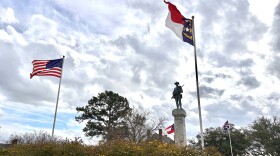Capital Square in downtown Raleigh looks a lot different than it did one year ago. That’s because one of the most iconic Confederate monuments in the state is gone. All of it.
The 75-foot-tall granite monument overlooked Hillsborough Street since 1895, spurring the erection of similar monuments across North Carolina.

James Williams, the retired chief public defender for Orange and Chatham Counties, chairs the North Carolina Commission on Racial and Ethnic Disparities in the Criminal Justice System (NC CRED). Williams says he enjoys seeing a patch of grass where that monument once stood.
"I know what that statue stood for, what it represented," said Williams, sitting on a bench near the empty space. "Having a monument that speaks to 'slaveocracy,' sends the exact opposite message, particularly to Black people, that they can expect fairness and fair treatment."
But in some cases – even though the monuments have been removed – the pedestals are still there. Williams says that has to change.
"That base says to me – and that is the problem with race and racism in America – quite often we do the superficial. We don’t dig down deep to the root," said Williams. "We’ve got to dig down deep to the root to remove those pedestals that form the base to those monuments of racial hatred in this country."
The Southern Poverty Law Center, based in Montgomery, Alabama, is working to get these confederate statue-less pedestals removed – challenging states and counties to, as they put it, "finish the job." The SPLC is amending its records in several cases, changing its "removed" confederate symbols classification, to "live."
Kimberly Probolus, a fellow at the SPLC, says leaving the confederate pedestals after statues are removed is a "troubling trend."
"There are 32 of these nationally, nine in North Carolina where the pedestals remain," said Probolus. "For us, they really symbolize the unfinished business of removing these symbols of hate and white supremacy from public space."
Probolus says these pedestals can be found from Asheville to Wilmington.
"We also recognize that taking down a monument is not going to eradicate racism or end white supremacy," said Probolus. "But we also know this is a really essential first step in creating more inclusive communities."

What Should Replace Confederate Monuments?
Sharon Crowell Harrell of Hertford County, recently traveled to the Halifax State Historic Site to see a statue she thought she would never see. A larger-than-life representation of abolitionist Harriet Tubman was on display, outside the front door.
"I told my husband, I got to go and see it before they pull her out," said a giddy Crowell Harrell. "I am going to get lots of pictures because this is history! I’m loving it!"

Vanessa Harrell lives in Charlotte and joined her sister-in-law on the trip to see the Harriet Tubman Underground Railroad statue, "The Journey to Freedom." Vanessa Harrell, who is African American, is torn over the removal of all Confederate statues. But she wants to see more truthful monuments to history.
"As far as seeing the statue here, it is confirming," said Vanessa Harrell. "I guess in a way for me, I know [slavery] happened, but to actually see an image, it becomes a little more tangible."
The Roanoke River glides through Halifax County and played a significant role in Black people finding freedom. Historic Halifax has two designations on the Underground Railroad to Freedom Network.
When the "Harriet" statue – an artist’s copy of an original private commission – left North Carolina, it went to New York, and then to the Harriet Tubman Museum in New Jersey. The original statue is in Texas.







